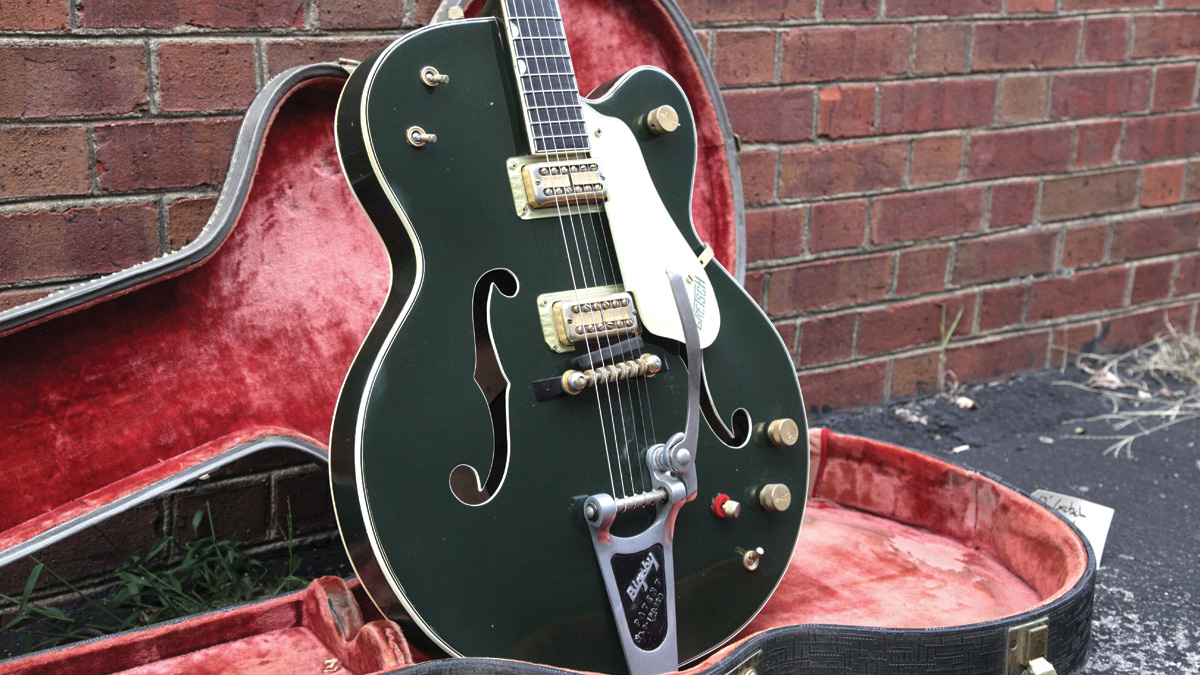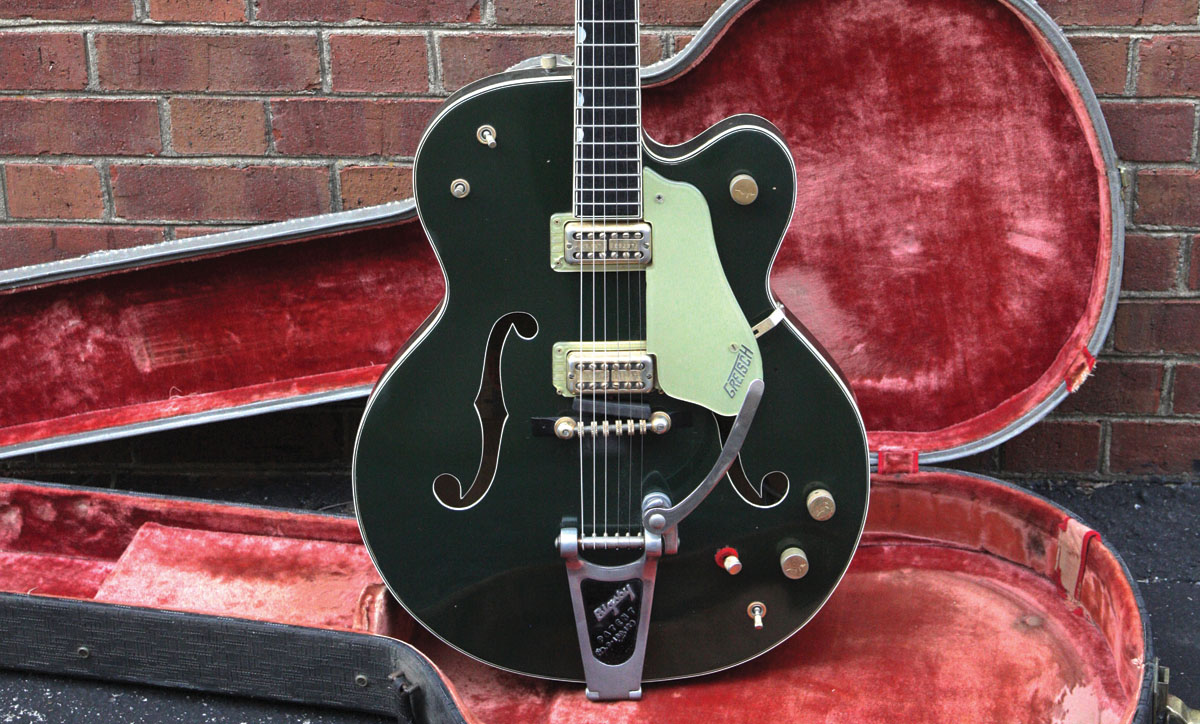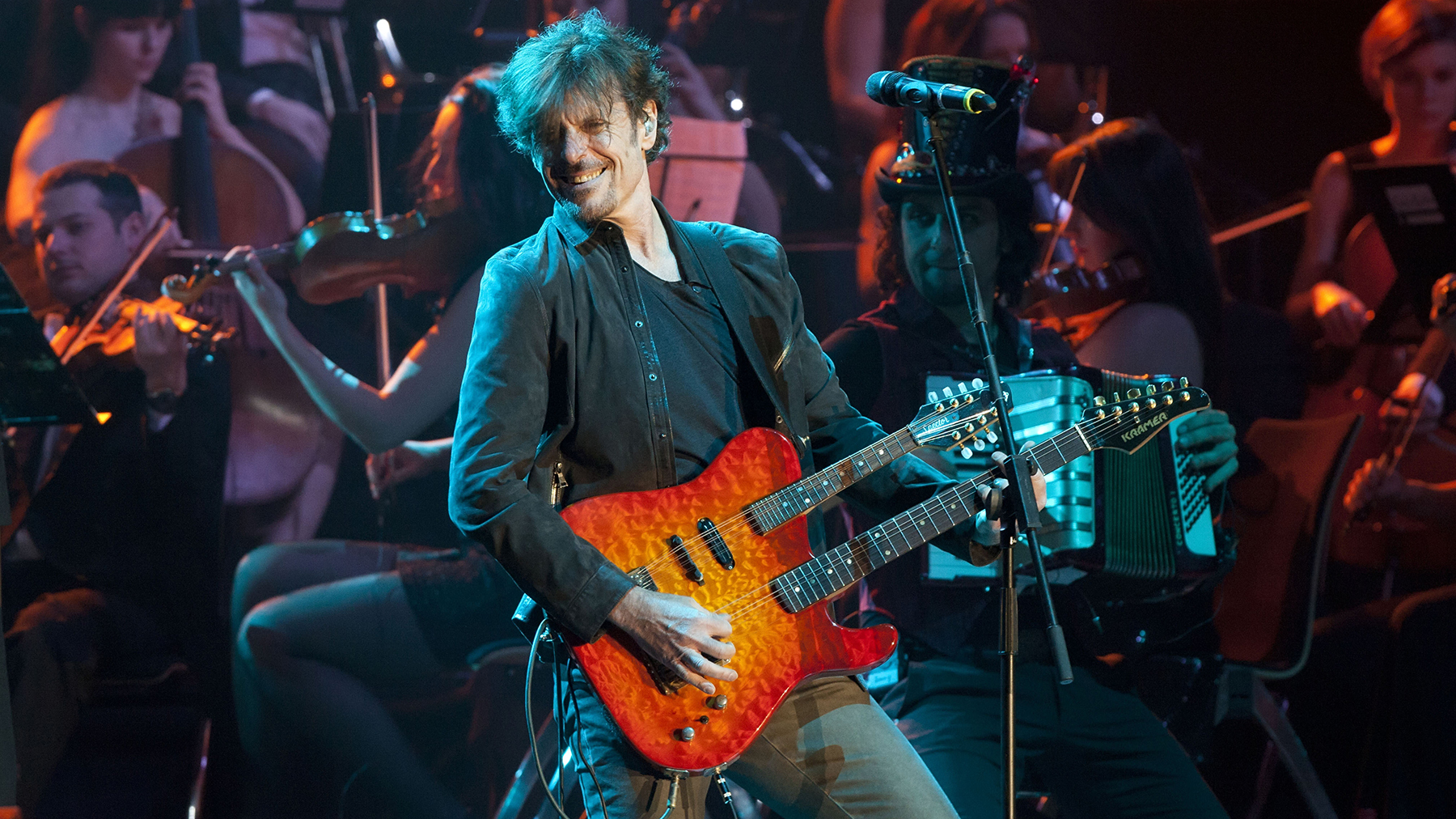Classic Gear: Gretsch 6196 Country Club
From the lineage of the Country Gent and White Falcon came an exalted, if lesser known, member of the Gretsch nobility.

What better vehicle to drive to the country club than a Cadillac? And what better guitar to pull out for that swanky gig than a Gretsch Country Club – and a Cadillac Green one at that.
Introduced in 1951, the Country Club had changed substantially by the time our featured example from 1962 arrived, embodying a form that will be more familiar to most of today’s players. Yet even then, it remained one of Gretsch’s grandest electric guitars, and a sign that a guitarist had “made it.”
Labeled with the 6196 model designation when dressed in a Cadillac Green finish, the Country Club sported a large, 17-inch-wide body like the Country Gentleman and top-of-the-line White Falcon, which was a clue to the guitar’s exalted lineage.
Even two decades later, the single-cutaway Country Club traced its roots to the big pre-war Gretsch jazz boxes that sported cat’s-eye soundholes and solid arched tops of carved spruce, formidable acoustic machines that sought to rival the big-bodied archtops of Gibson and Epiphone.
As amplification proved the way forward, the Country Club evolved into a shallower body made from laminated maple, with sturdier bracing to combat acoustic feedback. The body’s impressive width, however, and the guitar’s 25.5-inch scale length – the majority of Gretsch electrics, other than the White Falcon, have a 24.6-inch scale – continued to link it to its predecessors.
Incidentally, Gretsch made the guitar a full-depth model again in 1964, and the Country Club never moved into the double-cutaway body that most others adopted in the ’60s. Electronically, the Country Club toes the line for upper-range Gretsch guitars of the era. It evolved out of its DeArmond-made Dynasonic single-coil pickups in 1958 and into a pair of Gretsch-made Filter’Trons.
Designed by Ray Butts at the behest of Chet Atkins – and developed in the mid ’50s at a pace that rivaled Gibson’s PAF humbucker, which beat it into production by about one year – the Filter’Tron humbuckers delivered a crisp, bright performance that aimed to retain the existing characteristics of “that great Gretsch sound,” while effectively eliminating much of the 60-cycle hum.
Get The Pick Newsletter
All the latest guitar news, interviews, lessons, reviews, deals and more, direct to your inbox!
While they don’t offer the same midrange punch and easy grind as the slightly bigger, more powerful Gibson humbuckers, they do help the Gretsches that have them transition a little more easily from twang and jangle to crunched-up rock and roll. One element of the design that many players today might rather dispense with is the mechanical string mute.
Also found on other high-end Gretsch electrics of the day, it consisted of a bar covered with rubberized foam that could be raised up into contact with the strings between the bridge and bridge pickup by twisting a small knurled knob (the thing on the lower bout that looks like a miniature control knob, with a red felt protector ring beneath it).
This “bonus feature” hails from an era when it was apparently deemed worth cutting a couple of holes into the top of a perfectly good guitar to install a clunky device that would save you from having to palm mute the strings yourself, thereby producing that plinka-plinka guitar sound (and often slightly out of tune at that).
Given its body size, scale length, and electronics, this guitar is entirely comparable in sound and performance to the early ’60s White Falcon
Relatively few players ever used the thing, and many removed it from their guitars either to save weight or to eliminate the rattling sound they sometimes produce, so it’s a rarity to find it retained here.
Other features of the 1962 Country Club’s hardware and control set include individual pickup volume controls and a master volume (on the lower cutaway’s horn), but no tone controls, which were replaced, coincident to the arrival of the Filter’Trons, by a three-way tone switch on the upper bout, adjacent to the pickup selector switch.

The two-way toggle beside the mechanical mute knob on the lower bout is a signal-mute switch, or standby switch, which entirely cut the signal feed to the output jack (another of Gretsch’s unique selling propositions from the period), but quite unnecessary when you can just turn the master volume to zero instead.
• Fully hollow thinline single-cutaway body made from laminated maple
• Arched top braced with parallel “tone bars”
• Glued-in maple neck with bound ebony fretboard
• “Thumbnail” position markers
• Two Gretsch Filter’Tron pickups
• Cadillac Green finish
• Space Control bridge and mechanical string mute
The Bigsby vibrato tailpiece, optional in the day, and a period-correct addition here, retains smooth action over the Space Control bridge. Originally designed to allow easy user adjustment of string spacing, this bridge also has the benefit of smoothly rolling saddles that help to avoid string-hitch during vibrato use.
Up at the other end, across the zero fret that Gretsch guitars of the era carried, a set of Grover Imperial tuners dress up the headstock. All hardware is gold plated, and the multi-ply binding and purfling around the body, ebony fretboard, and headstock help to dress up the model.
Given its body size, scale length, and electronics, this guitar is entirely comparable in sound and performance to the early ’60s White Falcon, with a look that’s slightly understated, but still elegant and upmarket.
While the White Falcons of the era remain more collectible, players who prefer a little less flash and glitz will probably be drawn to the Country Club
While the White Falcons of the era remain more collectible, players who prefer a little less flash and glitz will probably be drawn to the Country Club. Despite its long list of pluses, the Country Club never garnered many famous players, and hence it never quite attained the iconic status of the 6120 Chet Atkins or White Falcon models.
But if you’re looking for a sound akin to what Stephen Stills, Neil Young, or Billy Duffy achieved on the latter, or a slightly tauter version of Brian Setzer or Reverend Horton Heat’s rockabilly on the former, the Country Club delivers, and with an upmarket sophistication all its own.
- Guitar courtesy of Rumble Seat Music.
Dave Hunter is a writer and consulting editor for Guitar Player magazine. His prolific output as author includes Fender 75 Years, The Guitar Amp Handbook, The British Amp Invasion, Ultimate Star Guitars, Guitar Effects Pedals, The Guitar Pickup Handbook, The Fender Telecaster and several other titles. Hunter is a former editor of The Guitar Magazine (UK), and a contributor to Vintage Guitar, Premier Guitar, The Connoisseur and other publications. A contributing essayist to the United States Library of Congress National Recording Preservation Board’s Permanent Archive, he lives in Kittery, ME, with his wife and their two children and fronts the bands A Different Engine and The Stereo Field.
Guitar Center's Guitar-A-Thon is back, and it includes a colossal $600 off a Gibson Les Paul, $180 off a Fender Strat, and a slew of new exclusive models
"We tried every guitar for weeks, and nothing would fit. And then, one day, we pulled this out." Mike Campbell on his "Red Dog" Telecaster, the guitar behind Tom Petty & the Heartbreakers' "Refugee" and the focus of two new Fender tribute models











